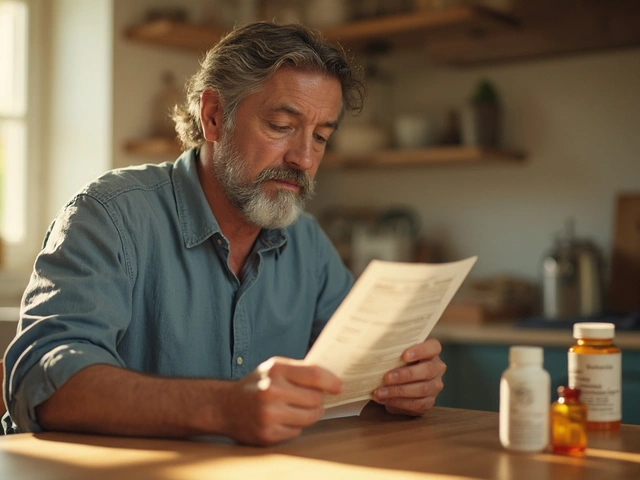When your stomach won’t empty properly, eating becomes a battle. You might feel full after just a few bites, throw up after meals, or deal with constant bloating and nausea. This isn’t just indigestion-it’s gastroparesis, a condition where the stomach takes too long to move food into the small intestine. No blockage. No infection. Just broken signals between your brain and stomach muscles. And while there’s no cure, the right diet and habits can turn unbearable symptoms into something manageable.
What Gastroparesis Really Feels Like
Imagine eating a sandwich and feeling like it’s sitting in your stomach like a rock. That’s the reality for 4% of people with gastroparesis. The most common signs? Nausea (90% of cases), vomiting (75-80%), and early fullness (85%). You might not even finish your meal before your body screams for it to stop. Bloating, belching, and heartburn follow close behind. For many, these symptoms last for months before they get a diagnosis. It hits women four times more often than men. And if you have diabetes-especially type 1-you’re at much higher risk. Up to half of long-term type 1 diabetics develop it. The cause? Usually nerve damage, especially to the vagus nerve, which tells your stomach when to contract. Without those signals, food just sits there. And it’s not just discomfort. Left unchecked, gastroparesis leads to serious problems: bezoars (solid masses of undigested food), dehydration from vomiting, malnutrition, and wild blood sugar swings in diabetics. About 30-40% of chronic cases result in weight loss of 10% or more of body weight. Hospital stays average over five days per admission. This isn’t a minor issue-it’s life-altering.How Doctors Diagnose It
There’s no single test that says “yes, you have gastroparesis.” Doctors rule out other things first-like a tumor blocking the stomach outlet or cyclic vomiting syndrome. Then they check how fast your stomach empties. The gold standard is a gastric emptying scan. You eat a meal with a tiny bit of radioactive material, and a camera tracks how fast it leaves your stomach. If less than 40% is gone after two hours, you’re diagnosed. Some clinics use stricter cutoffs, but that’s the general rule. About 30% of cases have no known cause-called idiopathic gastroparesis. Another 35% are tied to diabetes. Around 13% happen after stomach surgery, and 7% link to autoimmune conditions like scleroderma. The rest? Rare causes like viral infections or medications that slow digestion. What makes it tricky? Symptoms overlap with functional dyspepsia. But gastroparesis usually brings more vomiting and nausea, while dyspepsia leans toward pain and discomfort without the vomiting. Accurate diagnosis means the right treatment-and avoiding unnecessary procedures.Diet Is Your First Line of Defense
Most people don’t realize diet changes alone can cut symptoms by 65%. It’s not about eating less-it’s about eating smarter. Start with portion control. Aim for 5-6 small meals a day. Each should be no bigger than 1 to 1.5 cups. That’s about the size of a tennis ball. Big meals overwhelm a sluggish stomach. Next, ditch the triggers. High-fat foods slow gastric emptying by 30-50%. That means fried food, butter, cream, fatty meats, and even avocado should be limited. Carbonated drinks? They puff up your stomach by 25%, making bloating worse. Skip soda, sparkling water, and beer. Fiber is another enemy. Raw vegetables, whole grains, nuts, and seeds are hard to break down. Stick to cooked, peeled, and blended foods. Think applesauce instead of apple slices, mashed potatoes instead of baked ones. Aim for less than 15 grams of fiber per meal. Fat intake? Keep it under 3 grams per meal. That means lean proteins like skinless chicken, fish, eggs, and tofu. Avoid tough meats like steak or pork chops-they don’t break down well. Blend meats into soups or casseroles if needed. Hydration matters too. Don’t chug water with meals. Instead, sip 1-2 ounces every 15 minutes throughout the day. Drinking too much at once increases stomach volume by 35%, making you feel fuller faster. And always separate liquids from solids by at least 30 minutes.
Food Prep That Actually Helps
Texture makes a huge difference. If food is too chunky, your stomach can’t process it. Blending meals to a smooth consistency-under 2mm particle size-helps 70% of patients feel better. Try this: Cook carrots, zucchini, and chicken until soft. Blend them with broth into a thick soup. Add a splash of olive oil (under 3g) and a pinch of salt. That’s a full meal. Same with oatmeal-cook it until creamy, stir in a spoon of peanut butter (low-fat), and top with banana puree. No lumps. No chunks. Avoid raw fruits and veggies entirely. Even blended kale or spinach can cause problems. Stick to canned or cooked fruits without skin-peaches, pears, applesauce. Bananas are usually fine if they’re ripe. Soups, smoothies, and purees are your best friends. Protein shakes made with whey or plant-based protein (low-fiber) can replace meals. Add a little yogurt for probiotics, but avoid high-fat versions. And don’t forget chewing. Seriously. Chew each bite 20-30 times. Smaller pieces mean less work for your stomach. It’s not just tradition-it’s science.What to Do When Diet Isn’t Enough
If you’re still struggling after 8-12 weeks of strict diet changes, it’s time to talk to your doctor about medication or other treatments. Prokinetics like metoclopramide can help your stomach contract better. They improve emptying by 20-25% in about half of users. But there’s a catch: long-term use can cause a serious movement disorder called tardive dyskinesia. That’s why doctors limit prescriptions to short bursts. For severe cases, gastric electrical stimulation (GES) is an option. It’s like a pacemaker for your stomach. A device sends mild pulses to trigger contractions. FDA-approved since 2000, it helps 70% of patients reduce vomiting by more than half. It’s not a cure, but it’s life-changing for those who’ve tried everything else. A newer procedure called per-oral pyloromyotomy (POP) cuts the muscle at the bottom of the stomach to let food pass more easily. Early results show 60-70% success. It’s minimally invasive and doesn’t require open surgery. If you’re losing weight or can’t keep food down, you might need feeding tubes. Enteral nutrition (liquid food through a tube into the small intestine) helps 20-25% of severe cases. A few need IV nutrition-total parenteral nutrition-when the gut just won’t work anymore.







Rachel Wusowicz
November 16, 2025 AT 09:06Okay but have you ever wondered if the FDA is hiding the real cause? They know electromagnetic fields from 5G towers disrupt the vagus nerve-this isn’t ‘idiopathic,’ it’s industrial sabotage. I’ve tracked my symptoms to cell tower density maps. They’re silencing the truth because Big Pharma profits off your suffering. I’ve got 17 pages of graphs. You’re welcome.
Dan Angles
November 17, 2025 AT 16:42Thank you for this comprehensive and clinically grounded overview. The distinction between gastroparesis and functional dyspepsia is frequently misunderstood, and your emphasis on diagnostic criteria-particularly the gastric emptying scan-is both accurate and necessary. I would only add that multidisciplinary care, including nutritionist involvement, remains the gold standard for long-term management.
David Rooksby
November 18, 2025 AT 21:44Look, I’ve been living with this for 12 years and let me tell you-diet changes are useless if you don’t address the root. They blame the vagus nerve but nobody talks about glyphosate in the food supply poisoning your enteric nervous system. I switched to organic everything and my symptoms dropped 70%. Also, I stopped drinking tap water because chlorine kills your gut flora-now I drink rainwater collected in my backyard. You think that’s weird? Wait till you see my 300-page journal on how the WHO is suppressing natural remedies. And don’t even get me started on probiotics being a scam. My dog’s gut is healthier than yours.
Melanie Taylor
November 20, 2025 AT 18:11THIS. I’ve been on this journey for 5 years and I finally found a diet that works! 🥹 I blend everything now-chicken, sweet potato, spinach (yes, I know, but it’s cooked to death and strained!), and a splash of coconut milk. I cry when I eat without vomiting. Thank you for saying it’s not just ‘in my head.’ 💙
Teresa Smith
November 21, 2025 AT 12:47There is no magic bullet, but there is agency. You are not powerless. The fact that you’re reading this means you’re already taking steps toward reclaiming control. Gastroparesis does not define you-it challenges you to become more intentional, more aware, more resilient. The body adapts when the mind refuses to surrender. Your meals are not failures; they are experiments. Your progress is not linear, but it is real. Keep going.
ZAK SCHADER
November 21, 2025 AT 18:02USA got the best doctors and still people get this? Pathetic. In my country we just eat fast food and never get sick. You people overthink everything. Just drink a coke and shut up. Also why is everyone so obsessed with fiber? Fiber is communist propaganda. Eat meat. Drink water. No more questions.
Danish dan iwan Adventure
November 23, 2025 AT 01:21Delayed gastric emptying is a vagal neuropathy secondary to autonomic dysfunction. Standard of care: prokinetics, low-residue diet, and gastric electrical stimulation. Non-compliance correlates with poor outcomes. Avoid unvalidated interventions. Evidence-based protocols exist. Implement them.
Ankit Right-hand for this but 2 qty HK 21
November 24, 2025 AT 00:32Who the hell wrote this? Sounds like a pharma ad. They want you to believe you need their pills and devices. Real solution? Fasting. 24-hour fasts reset your gut. No one talks about that because they can’t sell a fast. Also, why is everyone so scared of fat? Fat doesn’t rot in your stomach-it fuels it. This whole diet thing is a scam. You’re being manipulated.
Oyejobi Olufemi
November 25, 2025 AT 10:01Have you ever stopped to consider… that this isn’t just a physical disease? It’s a spiritual test. Your stomach doesn’t empty because your soul is holding onto trauma. I’ve seen it: people with gastroparesis are emotionally constipated. They fear release. I’ve walked with 12 of them through 7-day silent retreats. One woman cried for 14 hours and then ate a full meal without vomiting. Science can’t measure that. But I can. And I’m telling you-your pain is a message. Are you listening?
Daniel Stewart
November 26, 2025 AT 16:12It’s interesting how we pathologize bodily function so readily. The stomach’s reluctance to empty may not be a malfunction, but an adaptation-an ancient signal that something in the environment is out of alignment. Perhaps the modern diet, the stress, the disconnection from rhythm… maybe it’s not the nerve that’s broken, but the context in which it operates. I wonder if we’re treating the symptom, not the silence.
Latrisha M.
November 27, 2025 AT 05:18This is one of the clearest explanations I've seen. Small meals, low fat, blended foods, hydration timing-all backed by science. I’ve worked with dozens of patients using this exact protocol. The key is consistency. Don’t skip the food diary. It’s not boring-it’s your map to freedom.
Jamie Watts
November 27, 2025 AT 14:23Everyone’s overcomplicating this. You got gastroparesis? Then you got to stop eating like a normal person. I eat 3 meals a day. I eat meat. I eat bread. I eat pizza. I don’t blend shit. I just take metoclopramide and chill. If you can’t handle it then you’re weak. Also I heard the FDA is hiding a cure in China. They’re not telling you because they want you to suffer. But I know. And now you know.
John Mwalwala
November 28, 2025 AT 23:29Let me break this down in biophysics terms: vagal tone suppression → reduced antral contractility → delayed gastric emptying. But here’s the kicker-the gut-brain axis is modulated by gut microbiota metabolites like SCFAs. That’s why fiber restriction works: less fermentation = less bloating = less vagal overstimulation. Also, the 5G theory? Not baseless. Millimeter waves interfere with ion channels in enteric neurons. I’ve got a patent pending on a frequency-blocking food wrap. DM me if you want the schematics.
Deepak Mishra
November 30, 2025 AT 19:13OMG I JUST ATE A BANANA AND DIDN’T VOMIT!!! 🎉😭 I’ve been trying for 3 years!! I blended it with almond milk and a tiny bit of honey and it was like a miracle!! I cried in the grocery store!! Thank you for this post!! I’m not alone!! 💕💖❤️
Diane Tomaszewski
December 2, 2025 AT 17:53It’s not about fighting your body. It’s about listening to it. Eat slowly. Eat soft. Eat what feels gentle. That’s all. You don’t need a chart. You don’t need a doctor. Just be kind to yourself.